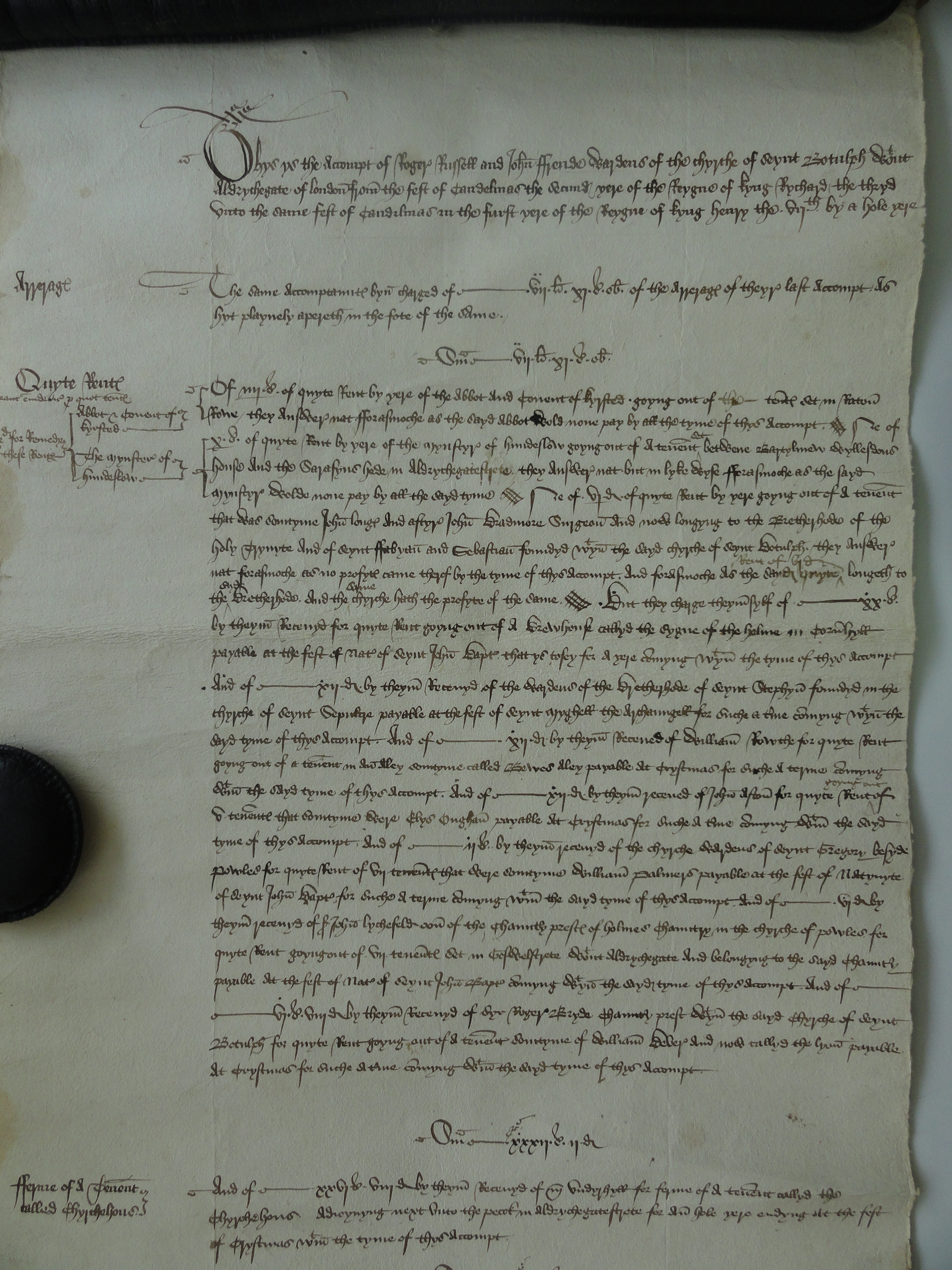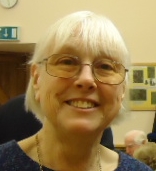Parish Memory: The Churchwardens’ Accounts of St Botolph’s without Aldersgate
Valerie Hitchman
The Churchwardens’ accounts help to build a picture of a parish providing both physical aspects and the social structure of the parish. They offer information on changes within specific geographic areas as well as nationally, and thus help us to follow England and Wales through the changing political and religious events.
During their term of office the churchwardens were responsible for managing the finances of the parish church; looking after the property owned by the church, collecting rents and the church rate, paying for repairs to the church building, furnishing and fittings, providing communion bread and wine, and many other miscellaneous items. At the end of each year, which usually ran from Lady day-to-Lady day (25 March), the churchwardens would present their accounts to the parish for approval.[i] These accounts are hand written and, although formulaic, they are also very individual and give clear insights into the parish and its affairs.
The parish of St Botolph’s just outside Aldersgate in London Wall is on a main route into and out of the City of London. The churchwardens’ accounts survive as rolls from 1466 – 1636 and thereafter in book form. Among the many duties of the churchwardens of St Botolph’s was the negotiation of tenancies and leases, as well as collecting the rents, for these properties. St Botolph’s owned several tenements; some appear to be single dwellings whilst others are divided into several units. Many of the dwellings changed tenant almost annually between 1466 and 1553.[ii] Nearly all are described as tenements; some with a location and some without. It is this aspect of the churchwardens’ responsibilities that will be looked at here.
- - -
The tenement in Blackhorse Alley was divided into seventeen individual apartments or rooms, which are usually identified by number in the accounts. Following the number, the rent is given and then the name of the tenant. Where the tenant has recently changed the previous tenant is listed as ’late in the hands of….’, ‘formerly in the hands of….’ or a similar phrase. The name of the previous tenant is usually omitted the following year.
William Rowth was the tenant of a tenement in Bewes Alley from 1479 to 1490 and from 1491 to 1517 he is listed as ‘late in the hands of'. During these later twenty-four years the following tenants occupied this property: Thomas Glassynbury (1491-1499), Thomas Cavendish (1500-1514), and – blank- Sheldon (1515-1517), but William Rowth continued to be listed as the previous tenant. Similarly, the tenement next to the White Hart had five different tenants between 1516 and 1553 but remained ‘late in the hands of Alan Johnson’.
There was a tenement in the Barbican with the tenant listed as ‘Brotherhood of the Holy Trinity of St Fabian & St Sebastian’ from 1479-1494 (15 years) with two previous tenants listed as ‘late in hands of John Bradmore and after John Long’ given each year (Figure 1). In 1495 the tenant is named as the ‘Brotherhood of St Stephen’; was this the same brotherhood with a changed name? No previous tenant is listed. In 1552 no current tenant is listed, but ‘Latelie belonging unto the Brotherhood of St Stephens’ is recorded.

Figure 1: This account from the first year of Henry VII's reign exemplifies the prominence of 'Quyte Rente'
(left margin) for the parish of St Botolph's Aldersgate. Reference to John Long, John Bradmore and the
'Bretherhode' is made in l. 6 of the respective section. Beginning of Roll 7, photographed by Gary G. Gibbs
and reproduced with kind permission from the churchwardens of St Botolph without Aldersgate.
The church house which might be associated with clergy, should more accurately be understood as ‘the church’s house’ in this parish, since the tenants were clearly laity. It was located next to ‘The Peacock,’ an alehouse on Aldersgate Street. Each tenant became the ‘late tenant’ whenever the tenancy changed. There was also a tenement with a garden without Temple Bar which stood at the western end of Fleet Street, thus marking the western limit of the City. Seven tenants occupied it during this period; sometimes the previous tenant was listed and occasionally not. The brew-house initially called the Lion, becoming the Red Lion from 1506, had a long remembered former tenant, William Bevyers 1468-1539 (71 years). The Lion / Red Lion was in the tenancy of the ‘occupiers of the chauntry in St Botolph Church’ throughout this time. The dissolution would have affected the chantry, but what happened to the Red Lion is unclear. It disappears from the accounts in 1539, and does not reappear before the end of this study.
The unidentified tenements present a problem. Are they single dwellings or multi dwellings which are sublet by the named tenant? For these properties there are variations in the records. Several of the tenements have a former tenant listed for many years, for example: William Palmer is listed as a previous tenant for at least 54 years (1468-1524), the actual length of his listing is unknown as he was already a former tenant in the first complete surviving account. Likewise with Ellis Ongeham who also appears in every surviving account as having been ‘sometime …’ the tenant of another tenement. In both these examples the ‘current’ tenant remained the same.
- - -
These are just a few of the properties that are listed in the churchwardens’ accounts, many of which were outside the parish. Why were the names of these past tenants remembered for so many years? With such long tenancies it, surely, was not needed as a means of identifying the property. Could it be a way of remembering previous, possibly important, parishioners? Did they bequeath the property to the church? Was this memory or necessity? Or was it that each new churchwarden just copied some of his predecessor’s entries in the accounts?

Valerie Hitchman is an Hon. Research Fellow at the University of Kent and a Fellow of My-Parish. She has directed the ‘Churchwardens' Accounts of England and Wales’ project based on this website and published widely on the subject. Her latest book is The Churchwardens' Accounts of St Botolph Without Aldersgate [1466-1500] (Leiden: Brill, 2024), co-edited with Gary Gibbs.
This blog post was specially written for the 22nd Warwick Symposium on Parish Research under the theme of ‘Parish Memory’ (University of Warwick, 11 May 2024).
- - -
[i] Although two churchwardens were appointed in most parishes, the appointment of three or four churchwardens can be found in some of the larger parishes. Also, Michaelmas (29 September) along with other dates are occasionally found as the accounting date.
[ii] Gary Gibbs and I have undertaken the task of transcribing these account rolls – this is as far as we have got. A first portion has just been published as: The Churchwardens' Accounts of St Botolph Without Aldersgate [1466-1500] (Leiden: Brill, 2024).
